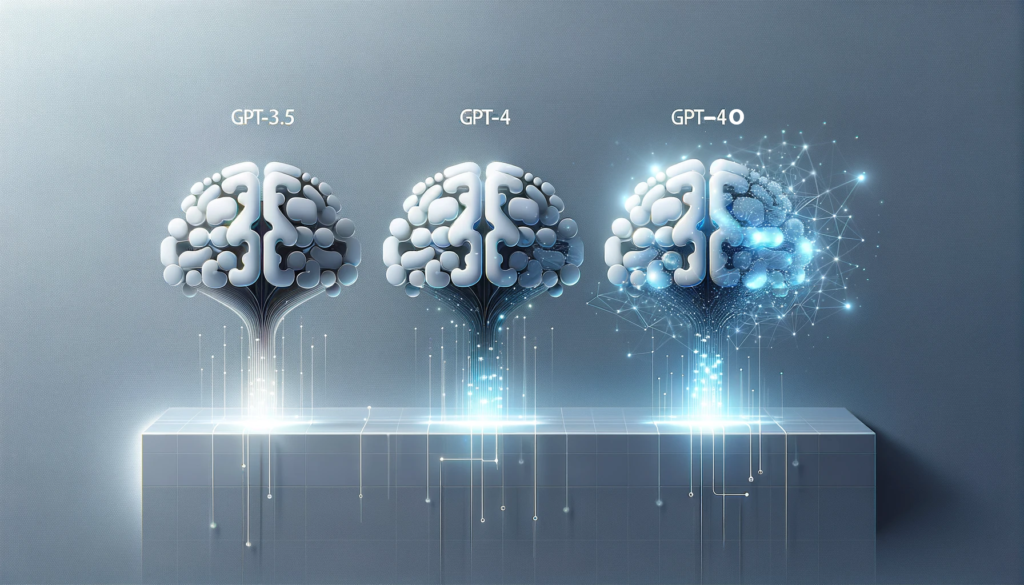GPT-3.5 vs GPT-4 vs GPT-4o: A Comprehensive Comparison
Introduction
The field of artificial intelligence (AI) has seen significant advancements over the past few years, particularly in the realm of natural language processing (NLP). OpenAI’s Generative Pre-trained Transformer (GPT) series has been at the forefront of this revolution. From GPT-3.5 to GPT-4 and the newly introduced GPT-4o, each iteration brings new capabilities and improvements. This article provides an in-depth comparison of these models, highlighting their key differences, strengths, and applications.
The Evolution of GPT Models
GPT-3.5: The Game Changer
Released in June 2020, GPT-3.5 was a landmark in AI development. With 175 billion parameters, it was the largest language model of its time. GPT-3.5’s architecture allowed it to perform a wide range of tasks, from language translation to question answering and creative writing.
Key Features of GPT-3.5:
- Scale and Capability: Its vast number of parameters enabled it to generate highly coherent and contextually relevant text.
- Versatility: Capable of handling numerous tasks without task-specific training.
- API Accessibility: OpenAI provided API access, allowing developers to integrate GPT-3.5 into various applications.
GPT-4: The Next Leap
Launched in March 2024, GPT-4 built upon the success of GPT-3.5 with several enhancements. While OpenAI has not disclosed the exact number of parameters, GPT-4 is believed to be significantly larger and more powerful.
Key Improvements in GPT-4:
- Enhanced Understanding: Improved comprehension and generation capabilities, making it more adept at understanding context and nuances.
- Better Performance: Superior accuracy in tasks like language translation, summarization, and dialogue generation.
- Increased Efficiency: Despite its larger size, optimizations in training and inference reduce latency and improve response times.
GPT-4o: Optimized for Efficiency
GPT-4o, or GPT-4 Optimized, represents a shift towards efficiency without compromising performance. This model is designed to deliver comparable results to GPT-4 but with enhanced efficiency, making it more suitable for real-time applications and environments with limited computational resources.
Distinct Features of GPT-4o:
- Resource Efficiency: Optimized architecture to reduce computational requirements and memory usage.
- Faster Response Times: Enhanced speed, making it ideal for applications needing real-time processing.
- Cost-Effectiveness: Lower operational costs due to reduced resource demands, beneficial for large-scale deployments.
Key Differences Between GPT-3.5, GPT-4, and GPT-4o

Scale and Complexity
- GPT-3.5: With 175 billion parameters, GPT-3.5 set a new standard for language models, balancing complexity with performance.
- GPT-4: While specifics are not disclosed, GPT-4 is presumed to be even larger and more complex, providing superior performance and accuracy.
- GPT-4o: Prioritizes efficiency, potentially with fewer parameters than GPT-4, but optimized to maintain similar performance levels.
Performance and Accuracy
- GPT-3.5: High performance across various NLP tasks but can struggle with extremely complex queries and nuanced understanding.
- GPT-4: Enhanced performance, particularly in understanding context and generating human-like text, with fewer errors and more precise output.
- GPT-4o: Maintains high performance similar to GPT-4 but optimized to be faster and more efficient, suitable for dynamic environments.
Efficiency and Speed
- GPT-3.5: Requires significant computational resources, which can lead to higher latency and operational costs.
- GPT-4: More efficient than GPT-3.5 but still resource-intensive due to its larger size and complexity.
- GPT-4o: Designed specifically for efficiency, offering faster response times and reduced resource consumption, making it ideal for real-time applications.
Use Cases and Applications
- GPT-3.5: Suitable for a wide range of applications, from chatbots to content generation and beyond. However, its high resource demand can be a limiting factor.
- GPT-4: Best suited for applications requiring deep understanding and high accuracy, such as advanced virtual assistants, sophisticated content creation, and complex data analysis.
- GPT-4o: Perfect for environments where efficiency and speed are critical, including mobile applications, real-time customer support, and large-scale deployment scenarios where cost and resource use are significant considerations.
Optimized Performance: The Case for GPT-4o
As AI technology continues to evolve, the demand for efficient, cost-effective solutions grows. GPT-4o addresses this need by providing a model that balances performance with efficiency. This makes GPT-4o particularly attractive for businesses and developers looking to deploy AI at scale without incurring prohibitive costs.
Advantages of GPT-4o
- Reduced Operational Costs: Lower computational requirements translate to cost savings, especially in cloud-based deployments where resource usage directly impacts expenses.
- Scalability: Enhanced efficiency allows for more scalable solutions, enabling the deployment of AI across multiple platforms and devices.
- Real-Time Processing: Faster response times are crucial for applications like customer service chatbots and real-time data analysis, where delays can significantly impact user experience.

Future Prospects and Developments
The advancements from GPT-3.5 to GPT-4 and the introduction of GPT-4o demonstrate a clear trajectory towards more powerful and efficient AI models. Future developments will likely continue this trend, focusing on increasing performance while reducing resource demands.
Potential Areas of Innovation:
- Adaptive Learning: Future models may incorporate more sophisticated mechanisms for continuous learning and adaptation, improving their ability to handle diverse and evolving tasks.
- Energy Efficiency: As sustainability becomes a priority, further optimizations in energy consumption will be critical, potentially leveraging novel hardware and algorithms.
- Accessibility: Making powerful AI models more accessible to a broader range of users, including those with limited technical expertise or resources, will drive wider adoption and innovation.
Conclusion
The evolution of OpenAI’s GPT series, from GPT-3.5 to GPT-4 and the optimized GPT-4o, highlights the rapid advancements in AI and natural language processing. Each model offers unique strengths, catering to different needs and applications.
- GPT-3.5 remains a versatile and powerful tool for various NLP tasks.
- GPT-4 enhances performance and accuracy, making it suitable for more demanding applications.
- GPT-4o strikes a balance between performance and efficiency, offering a cost-effective solution for real-time and large-scale deployments.
As AI technology continues to advance, these models will play a crucial role in shaping the future of intelligent systems, driving innovation across industries, and improving the way we interact with technology.








